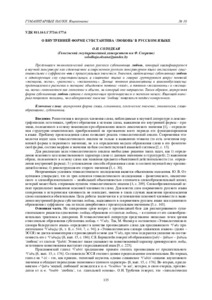Please use this identifier to cite or link to this item:
https://elib.psu.by/handle/123456789/23880Full metadata record
| DC Field | Value | Language |
|---|---|---|
| dc.contributor.author | Солодкая, О. И. | - |
| dc.date.accessioned | 2019-09-11T09:11:46Z | - |
| dc.date.available | 2019-09-11T09:11:46Z | - |
| dc.date.issued | 2019 | - |
| dc.identifier.citation | Вестник Полоцкого государственного университета. Серия A, Гуманитарные науки. - 2019. - № 10 – C. 135-139. | ru_RU |
| dc.identifier.issn | 2070-1608 | - |
| dc.identifier.uri | https://elib.psu.by/handle/123456789/23880 | - |
| dc.description | About Internal Form of Substantive ‘Любовь’ in the Russian Language A. Salodkaya | ru_RU |
| dc.description.abstract | Представлен этимологический анализ русского субстантива любовь, который квалифицируется в научной литературе как единственное в современном русском литературном языке отглагольное существительное с суффиксом -овь с процессуальным значением. Значения, свойственные субстантиву любовь и однокоренным ему существительным, в славянских языках и говорах группируются вокруг понятий «женщина, жена», «растение», «желанность». Данные понятия взаимосвязаны и взаимообусловлены: представления о растении и женщине объединяет понятие «плод», а понятия «желанность» и «женщина, жена» соотносятся как состояние и объект, на который оно направлено. Таким образом, внутренняя форма субстантива любовь связана с синкретичным представлением о женском начале. Языковой материал позволяет полагать, что абстрактное значение ‘любовь’ появляется позднее конкретного.= The article contains an etymological analysis of the Russian substantive любовь (‘love’), which is qualified in scientific literature as the only verbal noun in the modern Russian literary language with a -овь suffix with a procedural meaning. The meanings peculiar to the substantive любовь (‘love’) and the single-rooted nouns are grouped around such meanings as «woman, wife», «plant», «desire» in Slavic languages and dialects. These concepts are interrelated and interdependent: the concept of a plant and a woman combines the concept of «fruit, foetus», and the concepts of «desire» and «woman, wife» are related as a state and an object to which it is directed. Consequently, the internal form of the substantive любовь (‘love’) is tied to a syncretic understanding of female beginning. The language material suggests that the abstract meaning of ‘love’ appears later than the concrete one. | ru_RU |
| dc.language.iso | ru | ru_RU |
| dc.publisher | Полоцкий государственный университет | ru_RU |
| dc.relation.ispartof | Веснік Полацкага дзяржаўнага ўніверсітэта. Серыя А, Гуманітарныя навук | be_BE |
| dc.relation.ispartof | Herald of Polotsk State University Series A, Humanity sciences | en_EN |
| dc.relation.ispartof | Вестник Полоцкого государственного университета. Серия A, Гуманитарные науки | ru_RU |
| dc.relation.ispartofseries | Серия A, Гуманитарные науки;2019. - № 10 | - |
| dc.rights | open access | ru_RU |
| dc.subject | Государственный рубрикатор НТИ - ВИНИТИ::ОБЩЕСТВЕННЫЕ НАУКИ::Языкознание | ru_RU |
| dc.subject | Внутренняя форма слова | ru_RU |
| dc.subject | Семантика | ru_RU |
| dc.subject | Лексическое значение | ru_RU |
| dc.subject | Этимология | ru_RU |
| dc.subject | Словообразование | ru_RU |
| dc.subject | Субстантив. | ru_RU |
| dc.subject | Internal form of a word | ru_RU |
| dc.subject | Semantics | ru_RU |
| dc.subject | Lexical meaning | ru_RU |
| dc.subject | Etymology | ru_RU |
| dc.subject | Word formation | ru_RU |
| dc.subject | Substantive | ru_RU |
| dc.title | О внутренней форме субстантива ‘любовь’ в русском языке | ru_RU |
| dc.type | Article | ru_RU |
| dc.identifier.udc | 811.161.1'373.6:177.6 | - |
| Appears in Collections: | 2019, № 10 | |
Files in This Item:
| File | Description | Size | Format | |
|---|---|---|---|---|
| 135-139.pdf | 213.24 kB | Adobe PDF |  View/Open |
Items in DSpace are protected by copyright, with all rights reserved, unless otherwise indicated.